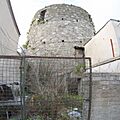List of windmills in County Down facts for kids
Windmills are amazing structures that use the power of the wind to do work, like grinding grain into flour or pumping water. For hundreds of years, they were super important machines before electricity came along.
This article explores some of the windmills that once stood, or still stand, in County Down, Northern Ireland. Many of these old mills are now just ruins, but they remind us of a time when wind power was a vital part of daily life.
Contents
What is a Windmill?
A windmill is a machine that converts the energy of wind into rotational energy. This energy can then be used for different tasks. The most common type of windmill you might think of is a tower mill. These mills have a tall, round or tapered tower, with a cap that can turn to face the wind. Large sails or blades are attached to the cap, catching the wind to make the machinery inside work.
Famous Windmills in County Down
County Down was once home to many windmills. Some of them are still standing today, even if they are no longer working. They are important historical landmarks.
Ballycopeland Windmill
One of the most famous windmills in County Down is the Ballycopeland Mill near Millisle. It's a fantastic example of a tower mill and was built around 1785. What makes it special is that it's the only working traditional windmill left in Northern Ireland! It has been carefully restored so visitors can see how it used to grind grain. It's a real step back in time. 54°36′28″N 5°33′22″W / 54.60781°N 5.5561°W
Other Notable Tower Mills
Many other places in County Down had tower mills. These strong structures were built to last and often had a long working life.
- The Ballyferis Mill in Ballywalter is another example of a tower mill. It was built in the 19th century. Today, only its base remains, but it's a reminder of its past importance.
- Near Boardmills, the Boardmills Mill was built around 1813. It was a tower mill that served the local community.
- The Cloghey Mill near Cloghey is another tower mill from 1836.
- In Crawfordsburn, the Crawfordsburn Mill was built in 1830. It's a tower mill that once helped the area.
- The Ballybryan Mill near Greyabbey is a 19th-century tower mill.
- Holywood also had its own Holywood Mill, a tower mill that was an important part of the town's history.
- The Killinchy Mill in Killinchy dates back to around 1702, making it one of the older tower mills in the area.
- In Killough, the Killough Mill was built in 1823.
- The Knockinelder Mill in Knockinelder is another tower mill that once stood tall.
- Newtownards had the Newtownards Mill, a tower mill that was part of the town's industrial past.
- The Portaferry Mill in Portaferry was also a tower mill.
- In Saintfield, the Saintfield Mill was a tower mill that helped the local economy.
- The Ringmackilroy Mill in Warrenpoint was a tower mill that was mentioned as early as 1802.
Windmills That Are No Longer Standing
Sadly, many windmills have disappeared over time. Some were demolished, while others were destroyed by accidents.
- The Ballyhalbert Mill in Ballyhalbert was a tower mill that was demolished in 1940.
- The Ballyholme Mill in Ballyholme had a dramatic end. It burnt down on 9 July 1922.
Other Windmill Locations
Many other places in County Down had windmills, even if we don't know much about them today. Records show windmills existed in places like:
- Ardkeen (1836)
- Ballyagherty (1779)
- Ballybohillbo (Ballybohillbo Mill)
- Ballydugan (1792)
- Ballygrainey (1836)
- Ballyherley (two mills, 1836)
- Ballykeel (1834)
- Ballymaconell (1836)
- Ballymenagh (1834)
- Ballyministragh (1836)
- Ballyorgan (1836)
- Ballyrogan (1836-1863)
- Ballyskeagh (1836)
- Ballytrustan (1836)
- Ballywalter (1681)
- Balloo (Ballyminstragh Mill)
- Carrowmacaw (1836)
- Cattogs (1836)
- Cullentra (1836)
- Dunoraver (1836)
- Ganaway (1836)
- Killyleagh (Ringdufferin Mill, two mills)
- Kirkistown (Kirkistown Mill)
- Lisbane (1836)
- Lisboy (1836)
- Poyntzpass (Poyntzpass Mill)
- Tullyboard (1836)
- Tullykevin (Tullykevin Mill)
- Whitechurch (1836)
These dates often show when the mill was first mentioned or when it was last known to be working. They give us clues about how widespread windmills once were across the county.
Images for kids
See also















